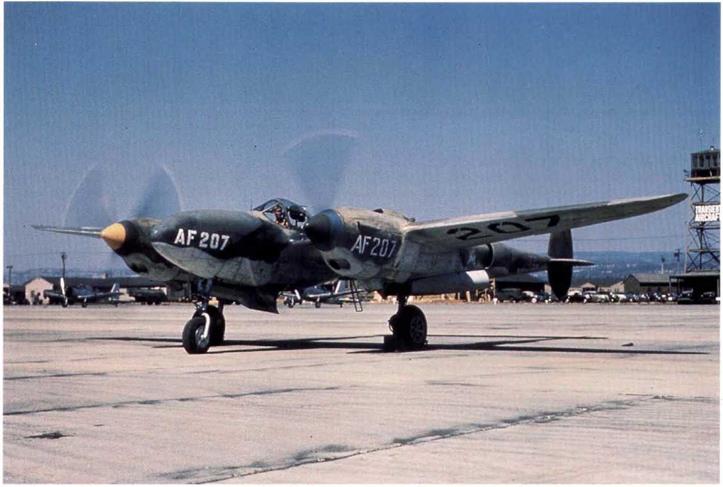Major Revision of T. O. 07-1-1 issued, June 1, 1942
A major revision of T. O. 07-1-1 was obviously required to cover all of the major changes made since the issue of T. O. 07-1-1, dated April 8, 1941 and T. O. 07-1-1 A, dated October 28, 1941, and this was released on June 1, 1942. The changes were underlined in the original document, and read as follows:
NOTE; The work directed herein will be accomplished as soon as possible by service activities with the aid of sub-depots, if necessary; however, a red diagonal on A. A.F. Form 41 will not be required in this case.
1. Camouflaging of Aircraft.
a. Types of Aircraft to be Camouflaged. – All United States Army Air Forces aircraft will be camouflaged in accordance with Army Air Forces Spec. 24114, with the following exceptions:
(2) Training types of aircraft…. These aircraft may be camouflaged by direction of Theater of Operation Commanders. Training Center Commanders, or Commanders of posts or schools to whom such authority mav be delegated.
b. Application of Camouflage Materials Over Existing Protective Coatings. Temporary camouflage materials, i. e.,
Paint. Water Dry, Army Air Forces Spec. 14057, as outlined herein, mav be applied over existing permanent camouflage finishes when required and as directed by Commanders in the Theaters of Operation.
d. Maintenance of Camouflage Surfaces. -…. Touching -up of permanently camouflaged surfaces is authorized if
required when the permanent camouflage has been partially destroyed by brushing action in removing the temporary camouflage outlined below.
e. Types of Camouflage Materials. -….. It will be noted that the use of both types of materials requires the use of a
primer.
f. Use of Special Color of Camouflage Materials.
(1) The basic camouflage scheme in permanent camouflage materials for Army Air Forces aircraft is as fob
lows;
(a) Dark Olive Drab. Shade No. 41. Bulletin 41. for surfaces viewed from above
(b) Neutral Gray, Shade No. 43. Bulletin 41, for surfaces viewed from below.
(2) For camouflaged aircraft operating over a terrain predominately green, the use of one coat of Medium Green Shade No. 42. Bulletin 41. in permanent Camouflage Materials is authorized.
(3) The use of the following shades of Paint. Water Dry, Spec. 14057, is authorized, when required, and as directed by Commanders in the Theaters of Operations.
(a) Sea Green. Shade No. 28. for upper surfaces when operating over terrain predominately preen.
(b) Black. Shade No. 33. for the lower surfaces of night-flying aircraft.
(c) Sand, Shade No. 26. for upper surfaces when operating over desert terrain.
2. Color of Painted Surfaces of Training Aircraft.
All training aircraft will have a finish as outlined in T. O.No. 0-1-3 or as specified in paragraph l. a.(2) of this Technical Order.
7. Organization Insignia.
a……… Rules governing design, submission of samples for approval, and use of organization insignia will be as out
lined in Army Air Forces Regulation No. 35-22.
T. O. 01-1-3, “Airplanes And Spare Parts, General – Airplane Finishes” was an old Spec, originally issued in 1925. The current version referred to above was dated January 11,1940, and stated that the standard colors for exterior surfaces were prescribed in Spec. 98-24113 (detailed earlier in this chapter – this is a good example of how service specifications are tiered, each one referring you to yet another spec.. This is true to this date – author).
|
Lockheed P-322, AF207, in RAF Dark Earth, Dark Green and Sky camouflage, is one of the 243 Lightning Mk. Is ordered by the RAF. They were rejected by the RAF because the lack of turbosuperchargers gave a much reduced performance. They were taken over by the AAF, given the non-standard designation of P-322, and used as trainers. Note the different colored spinners. (USAF) |
|
Curtiss P-40E of the 11th FS, in Alaska on July 15,1942, showing the huge “Aleution Tiger" markings on the nose, painted in yellow, black, and white. There are white stripes around the fuselage and on the rudder, identifying the 11 FS. Note that though the red center of the cocardes have been painted out, the "U. S.ARMY” markings under the wings have not, despite the order clearly stated that both were to be removed from all combat aircraft. (11SAFJ |












